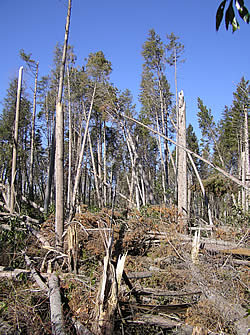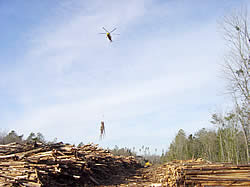
National Fire Plan Success Story
Restoration Project in Great Dismal Swamp Reduces Fire Risk and Regenerates Cedar Growth
Great Dismal Swamp, Virginia
National Fire Plan - Fuels Reduction

Storm damage in Great Dismal Swamp, post Hurricane Isabel. Photo courtesy USFWS.

Helicopter logging in Great Dismal Swamp. Photo courtesy USFWS.
Acres of young Atlantic White Cedar trees are beginning to come up in the Great Dismal National Wildlife Refuge as a result of the refuge's cedar regeneration project. The project began in 2005 after Hurricane Isabel slammed into the area and knocked down 3,600 acres of the indigenous, old-growth trees in the 110,000 acre refuge, which is located on the state line between Virginia and North Carolina.
In the storm's aftermath, dense flammable undergrowth created a fire risk and also prevented new seedlings from naturally regenerating. Additionally, the downing of huge numbers of trees meant a loss of environment for a variety of animals, insects and more than 20 different species of birds that depended on the cedar stands for breeding habitat.
To reduce the fire risk and also restore new, healthy tree growth to the area, loggers have been removing the downed trees and taking them to mills for processing. Woody undergrowth also is being cleared away to reduce fire fuel and create a receptive seed bed for new seedlings. Today, new cedar trees are naturally regenerated throughout the swamp. Wildlife Refuge staff are monitoring the re-growth through ongoing vegetation studies.
Local companies that have been assisting in the project include a local paper company that is growing seedlings from its own stock to replant in the swamp. The salvage crew is removing the downed trees and clearing out about 1,100 acres where the cedar trees once stood at no cost to taxpayers, as the contractor is keeping and selling the wood from trees recovered from the site.